Outer Banks, situated on the coast of North Carolina, is known for its beautiful beaches, charming lighthouses, and abundant wildlife. One of the most fascinating aspects of the region’s wildlife diversity is the bird population that calls it home.
From majestic birds of prey like bald eagles and ospreys to delicate shorebirds like sandpipers and plovers, the Outer Banks is a haven for birdwatchers and nature enthusiasts alike.
The coastal environment, which includes wetlands, dunes, and salt marshes, provides a unique habitat for a wide variety of bird species.
In this article, we will delve into the wonderful world of birds in the Outer Banks and discover the marvels of their behavior, ecology, and adaptations.
1. Carolina Wren
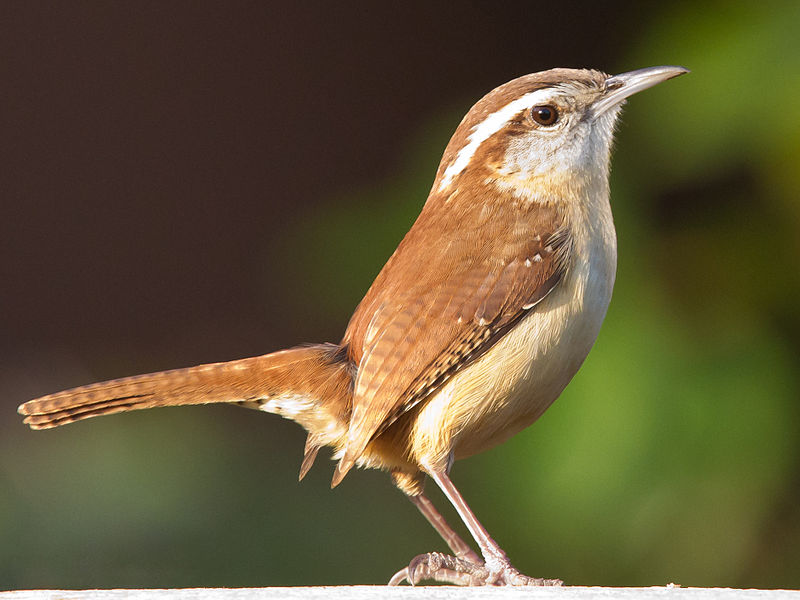
The Carolina wren (Thryothorus ludovicianus) is a medium-sized bird that can be found in the eastern United States, southern Ontario and northeast Mexico.
They typically live in dense shrubbery or thickets near open areas such as gardens, parks and woodland edges.
These birds are quite adaptable when it comes to nesting sites – they will build their nests anywhere from tree cavities to manmade boxes.
Their diet consists of insects, spiders and other invertebrates which they forage for on the ground or among vegetation.
The males have an unmistakable song made up of loud whistles interspersed with trills reminiscent of laughter; you’ll often find these cheerful little birds singing away during early morning hours.Scientific classification:
| Kingdom | Animalia |
| Phylum | Chordata |
| Class | Aves |
| Order | Passeriformes |
| Family | Troglodytidae |
| Genus | Thryothorus Vieillot, 1816[2] |
| Species | T. ludovicianus |
Also Featured In: Most Common United States Birds, Most Common Winter Birds
2. American Wigeon
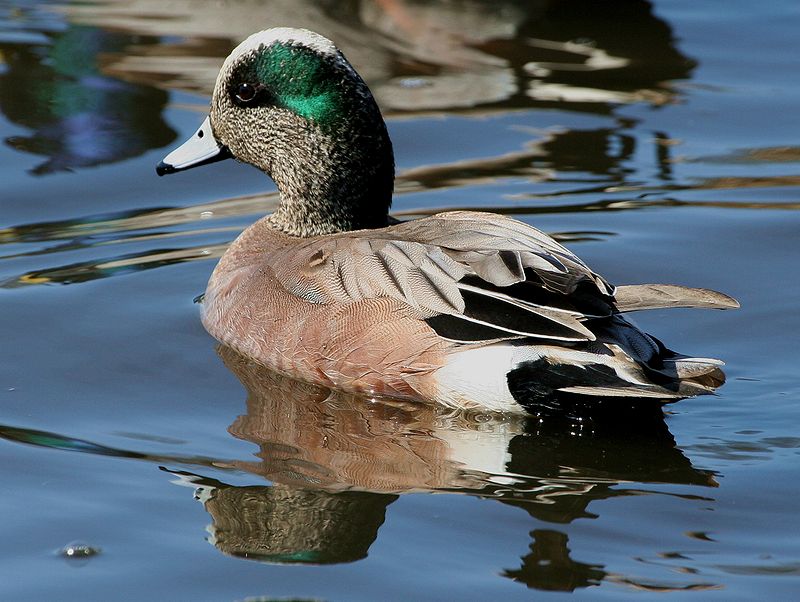
The American Wigeon, also known as the Baldpate, is a species of dabbling duck found throughout North America.
It closely resembles its Eurasian counterpart and was formally described in 1789 by German naturalist Johann Friedrich Gmelin.
This medium-sized bird has an overall grey body with white feathers on its face and belly that give it a distinctive bald appearance.
Its wings are brownish black with green speculum markings on them while the tail is dark brown or black at the base and gradually lightens near tips to become chestnut colored.
The male wigeons have purple patches on their heads during breeding season along with yellow eyes which helps differentiate them from females who have duller colors around their faces instead of bright ones like males possess.Scientific classification:
| Kingdom | Animalia |
| Phylum | Chordata |
| Class | Aves |
| Order | Anseriformes |
| Family | Anatidae |
| Genus | Mareca |
| Species | M. americana |
Also Featured In: Most Popular Bird Species in North America, Estuaries Birds
3. Yellow-Rumped Warbler

The Yellow-rumped Warbler (Setophaga coronata) is a migratory bird species that can be found throughout North America.
It has an extensive range, from the Pacific and Atlantic coats of the US to Canada and Central America, with a concentration in northern areas during breeding season.
These birds migrate southwards for wintering grounds where they find plentiful food sources such as insects and berries.
They are easily identified by their yellow patches on either side of their tails, along with white underparts, gray back feathers and two distinct crown stripes.
One black or greyish-brown above the eyes extending towards its neck banded in yellow or light brown colouration.
Furthermore, these warblers have strong legs which allow them to cling onto branches while hunting for prey making them adept at maneuvering through tree cover quickly.
All together this makes the Yellow-rumped Warbler an attractive backyard visitor year round.Scientific classification:
| Kingdom | Animalia |
| Phylum | Chordata |
| Class | Aves |
| Order | Passeriformes |
| Family | Parulidae |
| Genus | Setophaga |
| Species | S. coronata |
Also Featured In: Birds Live Near San Diego, New Hampshire Birds You Should Know
4. Canada Goose
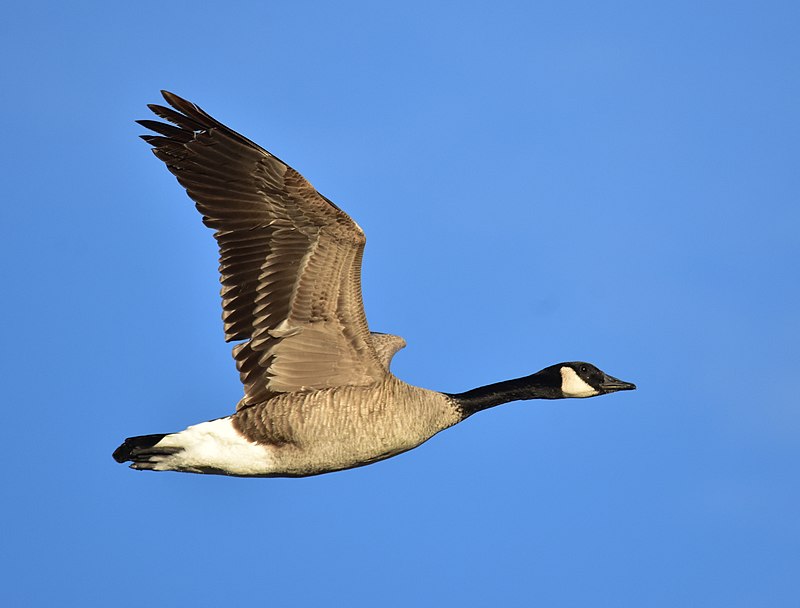
The Canada goose is a majestic bird with a black head and neck, white cheeks, chin and brown body. It’s native to North America but occasionally migrates to northern Europe across the Atlantic.
The species has been introduced in the United Kingdom, Ireland and Finland as well. Canada geese are strong flyers that travel in flocks for protection from predators; they also form monogamous pairs for life.
They feed on grasses or grains near ponds or wetlands where they make their nests of down which incubate eggs during summertime before hatching them out into goslings later on.Scientific classification:
| Kingdom | Animalia |
| Phylum | Chordata |
| Class | Aves |
| Order | Anseriformes |
| Family | Anatidae |
| Genus | Branta |
| Species | B. canadensis |
Also Featured In: Birds Live in Arkansas, Birds that Live in San Francisco Bay Area
5. American Black Duck
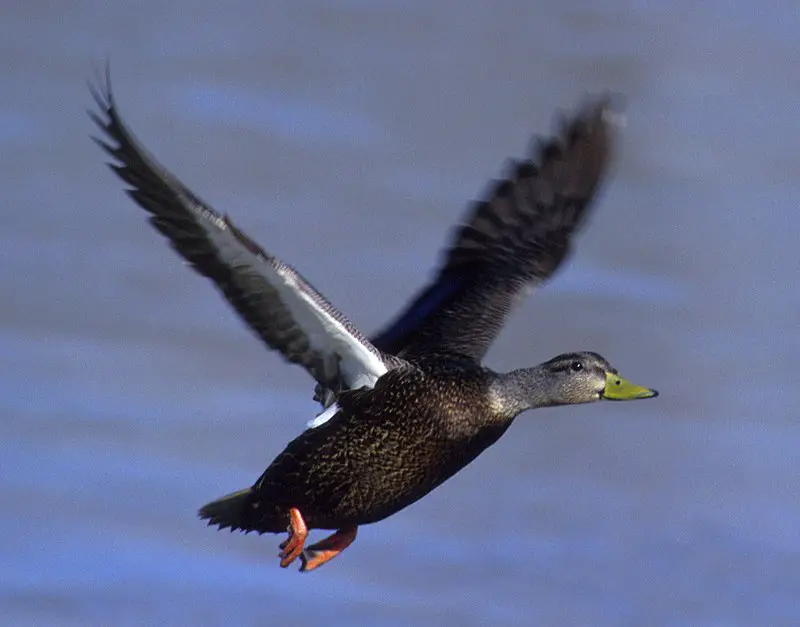
The American black duck is a large dabbling bird found in the Anatidae family. It has a dark brown plumage and measures between 21 to 23 inches in length, with an average wingspan of 35-37 inches.
This species can weigh anywhere from 1.59 – 3.62 lbs on average and are known as one of the heaviest ducks within their genus Anas.
They have similarities to female mallards but are generally darker overall which helps them stand out among other water fowls.
The American Black Duck mainly inhabits wetlands, marshes, lakes, rivers and estuaries across North America making it well suited for its aquatic lifestyle.Scientific classification:
| Kingdom | Animalia |
| Phylum | Chordata |
| Class | Aves |
| Order | Anseriformes |
| Family | Anatidae |
| Genus | Anas |
| Species | A. rubripes |
Also Featured In: Birds of Nova Scotia, Acadia National Park Birds
6. Canvasback
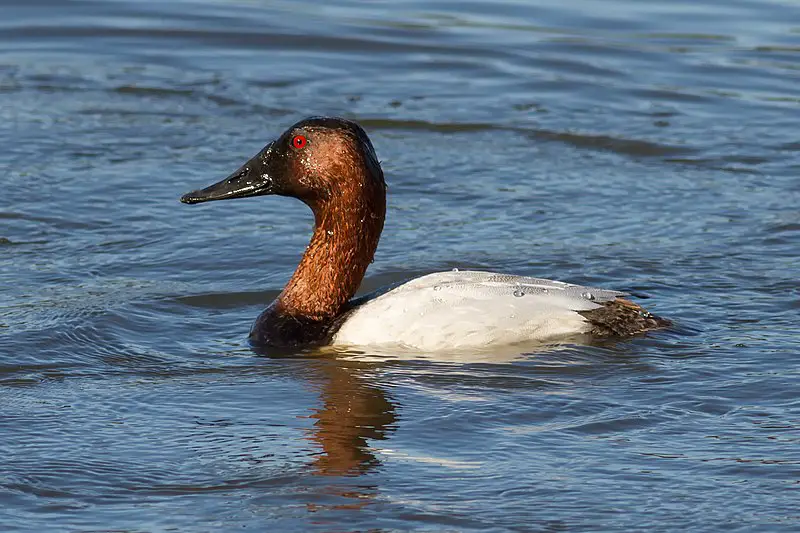
The Canvasback is a North American diving duck, the largest of its kind. It was first described by Scottish-American naturalist Alexander Wilson in 1814 who named it after two Greek words.
Aithuia, an unidentified seabird mentioned by authors like Hesychius and Aristotle; and Vallisneria americana which is wild celery.
Its body length ranges from 46 to 56 cm with males being larger than females on average but both have mottled grayish back feathers hence the name canvasback.
The ducks mainly feed on aquatic vegetation like tubers, roots as well as some insects during their breeding season.
They breed in large colonies near shallow wetlands making them vulnerable to habitat destruction due to human activities such as draining ponds or filling marshlands for development projects.
This has resulted in population decline of these birds across many areas over time leading governments and conservationists taking necessary measures for its protection through various initiatives such as preservation of wetland habitats etc.,Scientific classification:
| Kingdom | Animalia |
| Phylum | Chordata |
| Class | Aves |
| Order | Anseriformes |
| Family | Anatidae |
| Genus | Aythya |
| Species | A. valisineria |
7. Sanderling
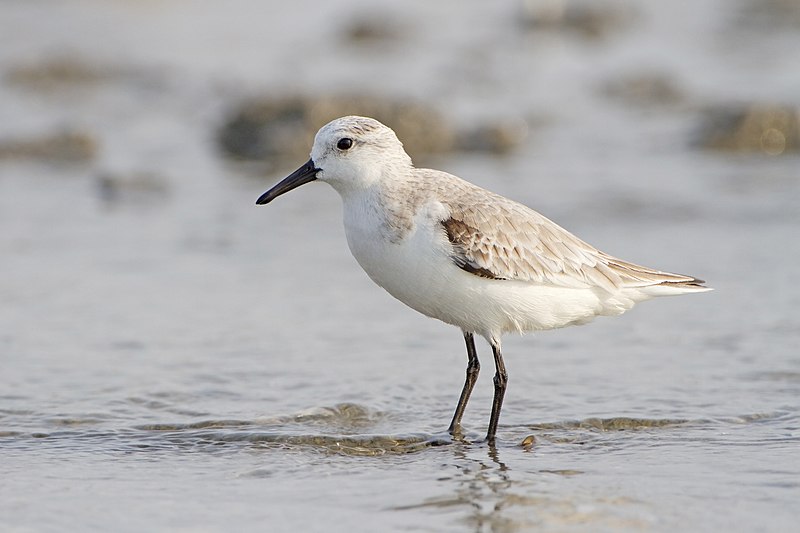
The Sanderling is a small wading bird that can be found in the Arctic region. Its name comes from Old English, meaning “sand-ploughman”. It has grey feathers and light legs which give it its distinct white coloration.
During summer breeding months, they are known to travel great distances – some wintering as far south as South America or Southern Africa. They typically feed on crustaceans such as shrimp and mollusks along coastal shores.
The Sanderling is an important species to watch out for because of their long migratory patterns and sensitivity to environmental change; if there’s trouble with this species then other birds may also be affected.Scientific classification:
| Kingdom | Animalia |
| Phylum | Chordata |
| Class | Aves |
| Order | Charadriiformes |
| Family | Scolopacidae |
| Genus | Calidris |
| Species | C. alba |
Also Featured In: Top Birds Found in Mexico, Galapagos Birds You Should Know
8. Great Egret

The Great Egret is a large, white bird found in many regions of the world. It has four subspecies that reside across Asia, Africa, Americas and southern Europe.
This species usually lives near bodies of water such as lakes and marshes. They are also now starting to spread into more northern areas of Europe due to climate change.
These birds have long yellow legs with an impressive wingspan for their size which allows them to soar majestically through the sky hunting for fish or amphibians in shallow waters below.
Their feathers have been used historically by Native Americans as part of traditional garments or ceremonies but this practice should be avoided today so these amazing creatures can thrive without harm from humans.Scientific classification:
| Kingdom | Animalia |
| Phylum | Chordata |
| Class | Aves |
| Order | Pelecaniformes |
| Family | Ardeidae |
| Genus | Ardea |
| Species | A. alba |
Also Featured In: Most common Birds in France, Most Common Romanian Birds
9. Great Blue Heron

The Great Blue Heron is a majestic wading bird found in many parts of North America, Central America, the Caribbean and even as far away as the Galapagos Islands.
It has an impressive wingspan which can reach up to six feet wide. Its feathers are mainly bluish-gray with brownish streaks on both its neck and chest while its head displays white plumes.
The adult herons can also be identified by their yellow bill and legs.
They live near bodies of water such as lakes, marshes or rivers where they feed on fish using a spear like motion with their sharp bills.
An all-white population exists only in south Florida and the Florida Keys making it quite unique.Scientific classification:
| Kingdom | Animalia |
| Phylum | Chordata |
| Class | Aves |
| Order | Pelecaniformes |
| Family | Ardeidae |
| Genus | Ardea |
| Species | A. herodias |
Also Featured In: Common Birds in Canada, Blue Birds You’ll Found around Us
10. Piping Plover
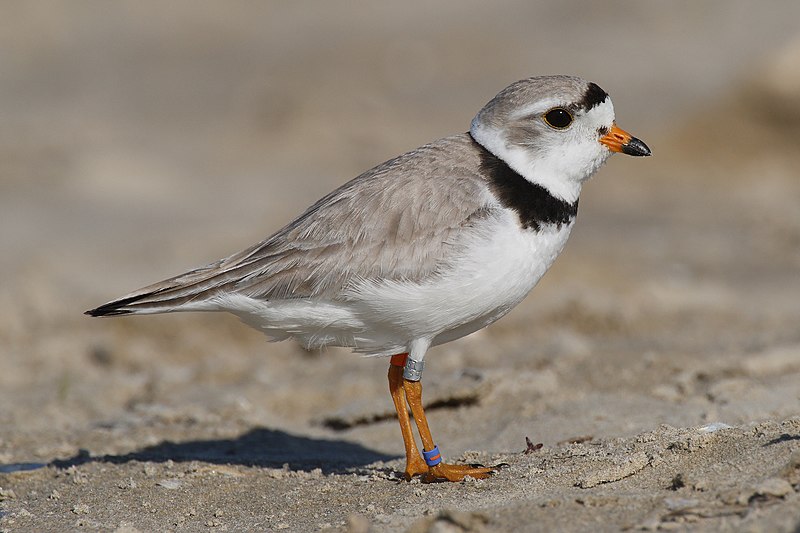
The Piping Plover is a small shorebird that can be found along sandy or gravel beaches in North America.
It has yellow-orange-red legs and its distinctive features include a black band across the forehead from eye to eye, as well as a thicker chest band for males during breeding season.
They are threatened by human activity on their habitats such as increasing development of coastal areas, destruction of their nesting sites due to recreation activities like beach driving and off-leash dogs.
Conservation efforts aim at protecting these birds through habitat protection measures including fencing off areas where they nest and restricting access during breeding seasons.
The future looks brighter with conservation initiatives by local governments slowly bringing the population up again over time.Scientific classification:
| Kingdom | Animalia |
| Phylum | Chordata |
| Class | Aves |
| Order | Charadriiformes |
| Family | Charadriidae |
| Genus | Charadrius |
| Species | C. melodus |
Also Featured In: Birds Commonly Found in New York, Long Island Birds You Should Know
11. Grey Plover
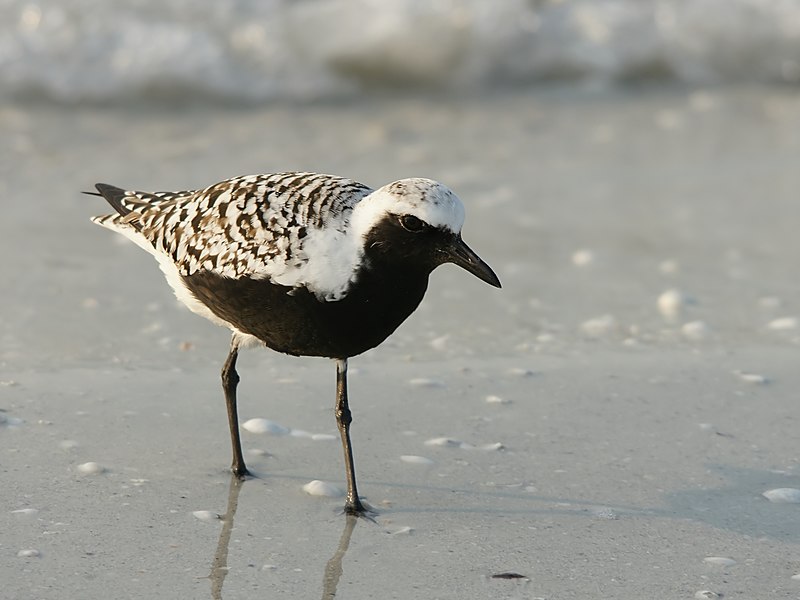
The Grey Plover is a large plover bird which breeds in the Arctic regions. It then migrates over long distances, and can be found on coastlines around the world when not breeding.
The species was first described by Swedish naturalist Carl Linnaeus in 1758 under its binomial name “Tringa squatarola”.
In addition to being known as grey plovers or black-bellied plovers, they are also sometimes referred to as “black-breasted lapwings” due to their distinctive plumage that features white underneath with dark greys above.
These birds inhabit beaches, mudflats and saltmarshes where they feed mainly on small invertebrates such as worms and insects.Scientific classification:
| Kingdom | Animalia |
| Phylum | Chordata |
| Class | Aves |
| Order | Charadriiformes |
| Family | Charadriidae |
| Genus | Pluvialis |
| Species | P. squatarola |
Also Featured In: Birds of Netherlands, Tundra Birds
12. Northern Gannet
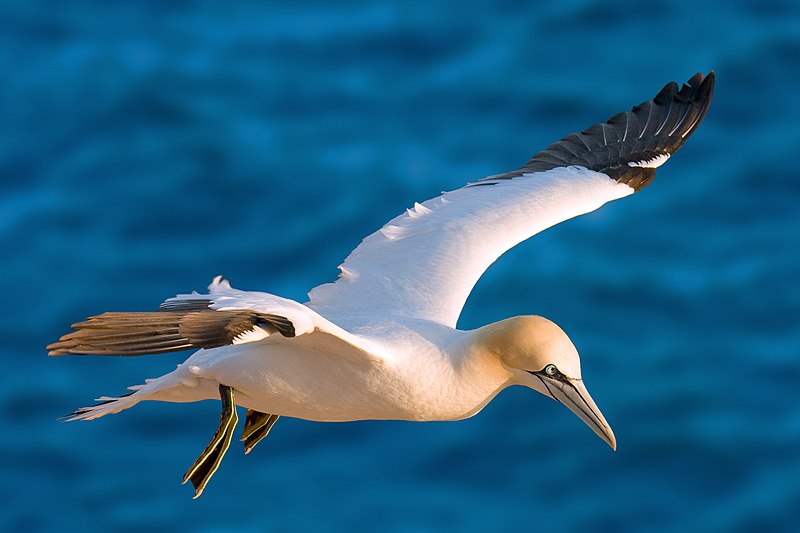
The Northern Gannet is the largest species of seabird in the northern Atlantic, with a white body and long neck.
It has yellowish head feathers and black tipped wings that can reach up to 6 feet across when fully extended.
The beak is large and orange-yellow in color. This bird breeds along western Europe’s coasts as well as northeastern North America.
They forage for fish by plunging into the sea from high above, making them an impressive sight to behold on any given day.
Their diet consists mainly of herring, mackerels or sand eels which they catch midair after diving at speeds reaching over 100 miles per hour.
With their striking features these birds are truly majestic creatures that have been around since prehistoric times – a testament to their hardiness and adaptability.Scientific classification:
| Kingdom | Animalia |
| Phylum | Chordata |
| Class | Aves |
| Order | Suliformes |
| Family | Sulidae |
| Genus | Morus |
| Species | M. bassanus |
Also Featured In: Birds found in portugal, Italian Birds You Should Know
13. Oystercatchers
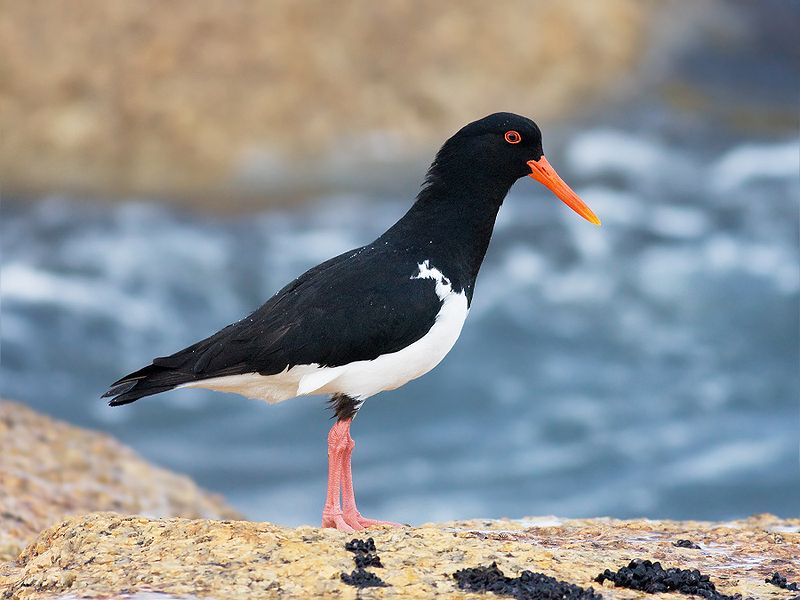
Oystercatchers are a family of waders forming the Haematopodidae, with one genus; Haematopus.
They live in coastal regions around the world excluding both polar and some tropical areas of Africa & South East Asia.
Eurasian, South Island & Magellanic oystercatcher species also breed far inland – breeding grounds being found much deeper than other members of the family.
They have long beaks used to feed on molluscs such as mussels, clams and oysters which they crack open using their strong bills.
Oystercatchers are usually quite vocal birds making various loud calls when disturbed or alarmed.
The males tend to display more brightly coloured plumage compared to females who share similar brown/black hues for camouflage purposes during nesting season.Scientific classification:
| Kingdom | Animalia |
| Phylum | Chordata |
| Class | Aves |
| Order | Charadriiformes |
| Suborder | Charadrii |
| Family | Haematopodidae Bonaparte, 1838 |
| Genus | Haematopus Linnaeus, 1758 |
Also Featured In: Best Birds Watching in Austria, Native Birds of Kazakhstan
14. Laughing Gull
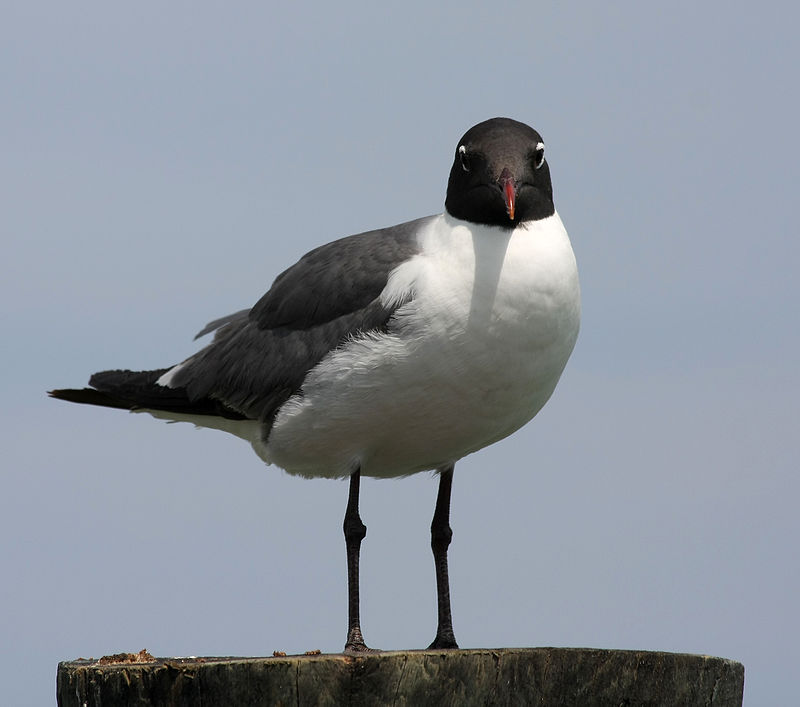
The Laughing Gull is a medium-sized bird with gray wings, black head and white underparts. It has bright red legs and bill which make it easily distinguishable from other gulls.
The name comes from its unique laughing call which can be heard in coastal areas throughout the Americas where they breed. They are opportunistic omnivores that feed on fish, carrion, insects or even garbage when available.
During breeding season these birds form large colonies along the Atlantic coast of North America as well as parts of northern South America and Caribbean islands.
There are two subspecies; L megalopturus found in Canada to Central America while L atricilla inhabits rest of their range..
These species have become more common inland due to human settlement near coasts creating ideal habitat for them but also making them scavengers around urban areas.Scientific classification:
| Kingdom | Animalia |
| Phylum | Chordata |
| Class | Aves |
| Order | Charadriiformes |
| Family | Laridae |
| Genus | Leucophaeus |
| Species | L. atricilla |
Also Featured In: Gulls Species, Birds You’ll Find in South Texas
15. Willet
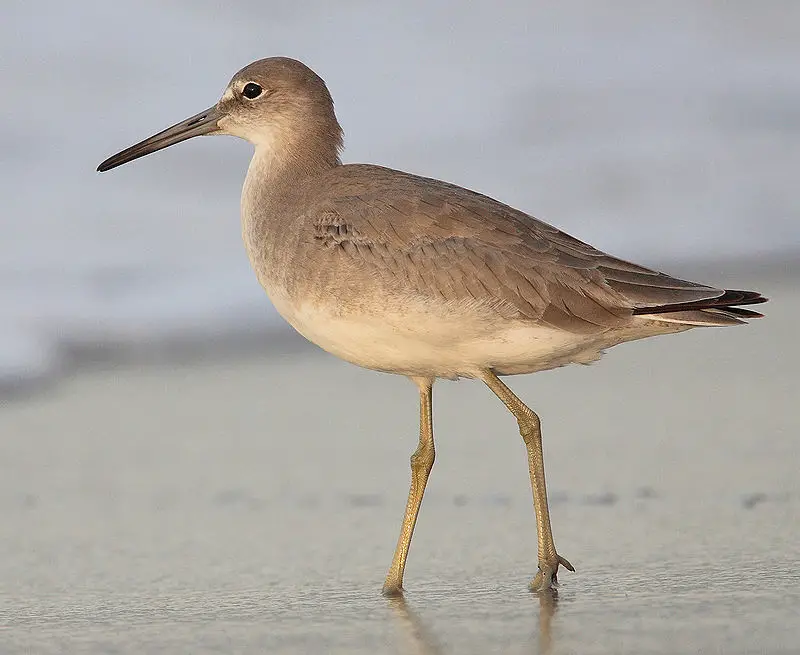
The Willet is a large and robust bird of the Scolopacidae family. It belongs to genus Tringa and it is much larger than its closest relative – lesser yellowlegs, which can be easily distinguished by its fine neck pattern.
The willet has brown upperparts with white patches on wings along with grey underparts. Its bill is thick, long and straight in shape having black coloration at tip while legs are also long but greenish-grey in colour.
They feed mainly on insects, worms or crustaceans that they find near coastal waters or wetlands as well as grains or seeds when available during winters.Scientific classification:
| Kingdom | Animalia |
| Phylum | Chordata |
| Class | Aves |
| Order | Charadriiformes |
| Family | Scolopacidae |
| Genus | Tringa |
| Species | T. semipalmata |
Also Featured In: birds of Delaware, Big Birds that Live in New Jersey
16. Green-Winged Teal
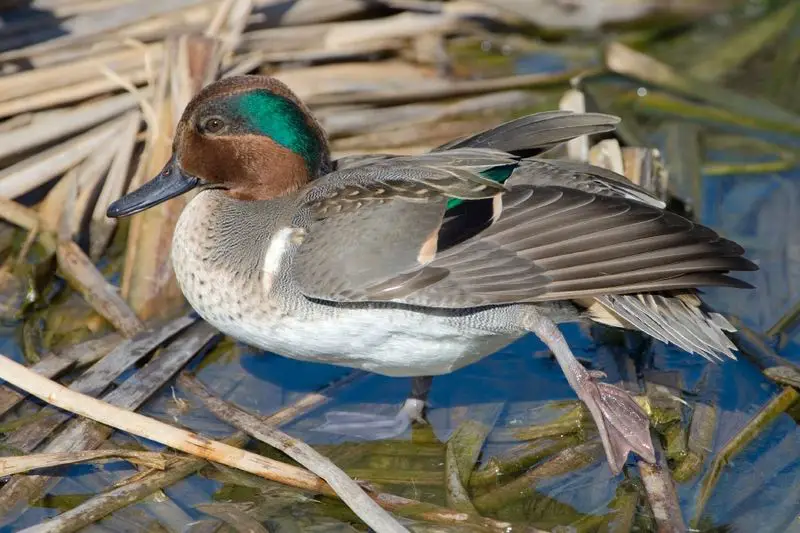
The green-winged teal is a common and widespread duck that can be found across most of North America, except for the Aleutian Islands.
It was once thought to belong to the same species as Eurasian teals but has since been classified differently by many authorities.
These small ducks have colorful wings which display shades of green and blue along with buffy brown coloration on their undersides.
The male birds are particularly striking during mating season when they acquire beautiful chestnut markings on their heads and upper breasts.
They feed mainly in shallow water bodies such as ponds, lakes, marshes or estuaries, eating aquatic invertebrates like snails or insects.
When disturbed they can fly away rapidly with a loud whistling sound produced by their wings during flight.Scientific classification:
| Kingdom | Animalia |
| Phylum | Chordata |
| Class | Aves |
| Order | Anseriformes |
| Family | Anatidae |
| Genus | Anas |
| Species | A. carolinensis |
Also Featured In: birds of green birds, Phoenix Birds You Should Know
17. Sandpiper
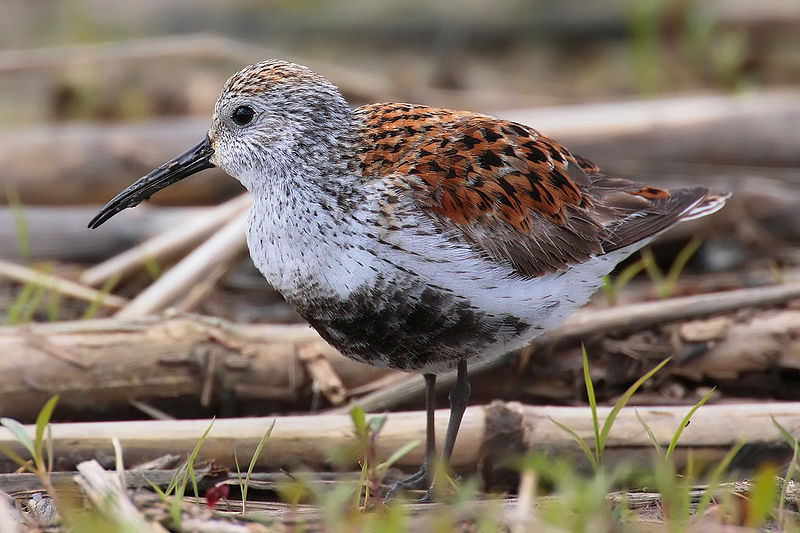
Sandpiper is a type of wading bird that belongs to the family Scolopacidae. It is a diverse family that includes various species such as curlew and snipe.
Sandpipers have different bill lengths that allow them to feed on small invertebrates and creatures found in mud or soil.
Due to this diversity, different species can coexist in the same habitat without competing for food.
Sandpipers are commonly found near the coast but are also found in other wetland environments.
They are known for their slender legs, long beak, and streamlined body that enables them to move easily in and out of water.
Sandpipers are a unique and fascinating bird species that are interesting to observe in their natural habitat.Scientific classification:
| Kingdom | Animalia |
| Phylum | Chordata |
| Class | Aves |
| Order | Charadriiformes |
| Suborder | Scolopaci |
| Family | Scolopacidae Rafinesque, 1815 |
Also Featured In: Birds You’ll Find in the Sea, Turkey Birds You Should Know
18. Brown Pelican

The majestic brown pelican is a dive-feeding bird that belongs to the pelican family. It is one of the three pelican species found in the Americas and is known to dive into water to catch its prey.
From the Atlantic Coast of New Jersey to the mouth of the Amazon River, and along the Pacific Coast from British Columbia to northern Chile, including the Galapagos Islands, this bird can be found.
Its scientific name is Pelecanus occidentalis, and it has a colored brown plumage, which is its distinct characteristic.
The brown pelican belongs to the largest bird species that exist today, with a wingspan that can stretch up to seven feet long.
This bird helps maintain a balance in the ecosystem by eating smaller fish, crustaceans, and other aquatic prey.Scientific classification:
| Kingdom | Animalia |
| Phylum | Chordata |
| Class | Aves |
| Order | Pelecaniformes |
| Family | Pelecanidae |
| Genus | Pelecanus |
| Species | P. occidentalis |
Also Featured In: Water Birds Live around Us, Flight Birds You Should Know
19. Northern Pintail
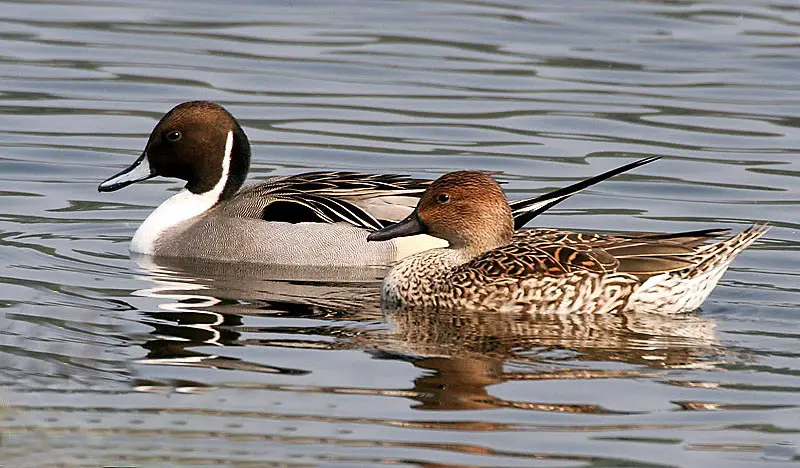
The Northern Pintail is a widespread duck species that breeds in northern parts of Europe, across the Palearctic and North America. This migratory bird winters south of its breeding range to the equator.
Unlike most birds with such a wide range, it does not have any subspecies. The male Northern Pintail has a distinctive long, thin tail and a chocolate-brown head. The female has a mottled brown body and a shorter tail.
This duck species prefers shallow wetlands or marshes for breeding and feeds on aquatic plants and insects.
The Northern Pintail is a highly migratory bird, covering great distances in search of suitable habitats.
Despite some threats, this species is not considered globally threatened, although certain populations are experiencing a decline in numbers.Scientific classification:
| Kingdom | Animalia |
| Phylum | Chordata |
| Class | Aves |
| Order | Anseriformes |
| Family | Anatidae |
| Genus | Anas |
| Species | A. acuta |
Also Featured In: Most Common Lake Birds, British Columbian Birds
20. American Kestrel
The American kestrel, also known as the sparrow hawk, is a popular falcon species in North America. It is the smallest falcon and can come in different sizes based on subspecies and sex.
Its weight ranges from that of a blue jay to a mourning dove. In addition to North America, this bird species is also found in South America.
There are 17 subspecies of American kestrels, each adapted to different environments.
Although small in size, the American kestrel is a fierce predator, often preying on insects, rodents, and other small birds.
Its impressive hunting skills and stunning coloration make it a favorite among birdwatchers and falconers alike.Scientific classification:
| Kingdom | Animalia |
| Phylum | Chordata |
| Class | Aves |
| Order | Falconiformes |
| Family | Falconidae |
| Genus | Falco |
| Species | F. sparverius |
Also Featured In: Birds That Live in Colorado, Birds that Live in the Deserts
21. Northern Harrier
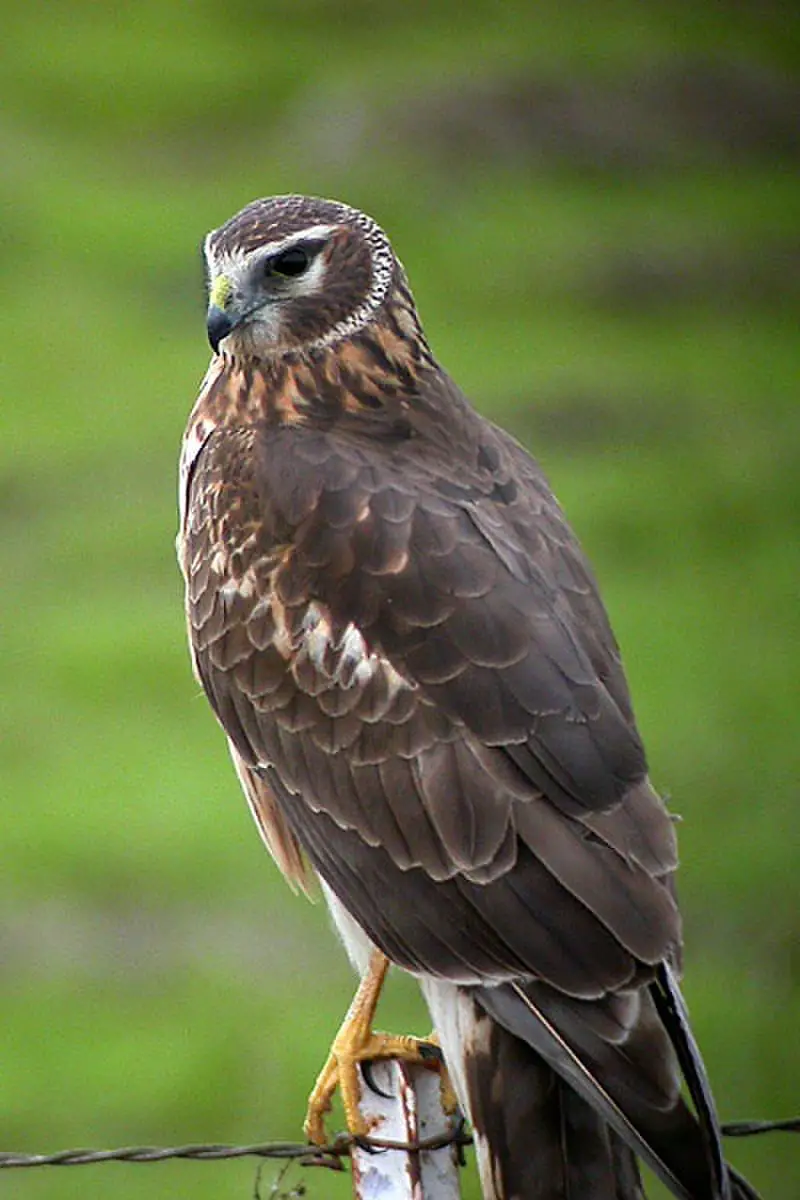
The Northern harrier, also known as the marsh hawk or ring-tailed hawk, is a bird of prey that can be found breeding in the northern parts of the northern hemisphere in Canada and the northernmost USA.
During winter, they migrate to more southerly areas, with breeding birds moving to the southernmost USA, Mexico, and Central America.
This hawk has a distinctive white rump patch that is visible during flight, making it easy to spot.
It is known for its unique hunting behavior, as it searches for prey by flying low over fields and marshes, using its incredible hearing to detect prey beneath the surface.
The Northern harrier feeds on small mammals, birds, and even insects.
They are important both ecologically and culturally and are a common sight for bird watchers in their respective habitats.Scientific classification:
| Kingdom | Animalia |
| Phylum | Chordata |
| Class | Aves |
| Order | Accipitriformes |
| Family | Accipitridae |
| Genus | Circus |
| Species | C. hudsonius |
Also Featured In: Birds that Live in the Grasslands, Common Winter Birds of New Brunswick
22. Tricolored Heron
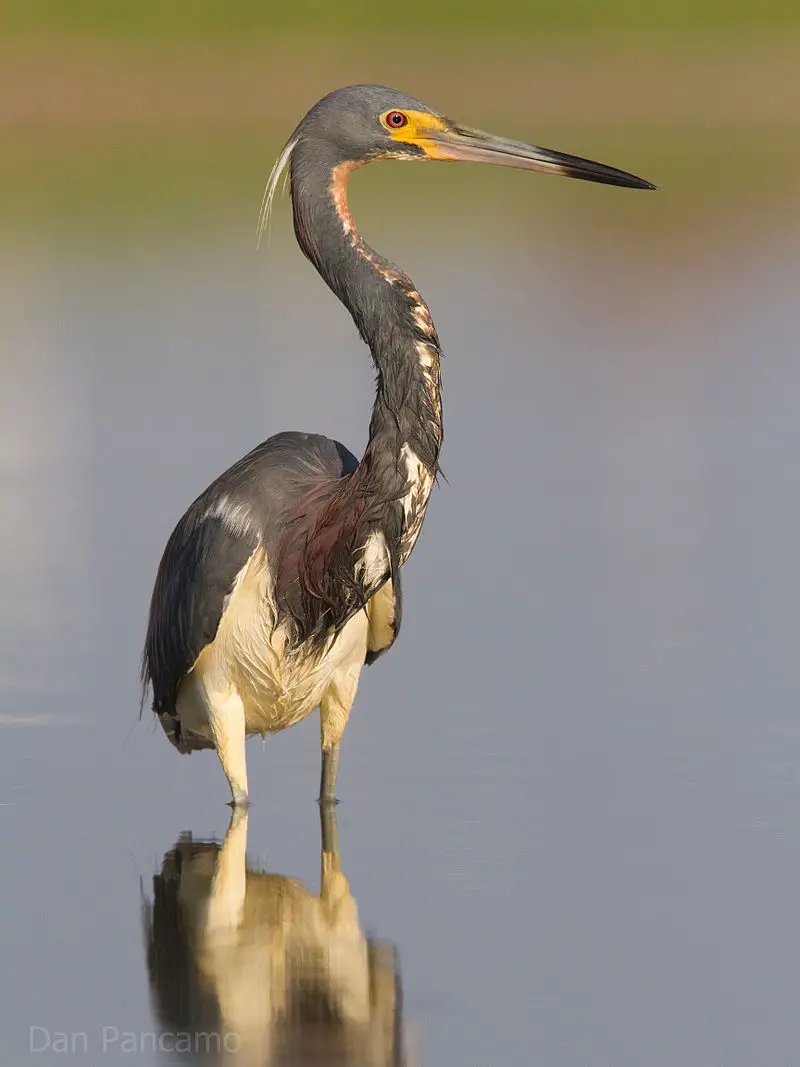
The Tricolored heron, also known as Egretta tricolor, is a species of heron found in coastal areas of the Americas. Unlike other types of herons, the Tricolored heron is more solitary and primarily feeds on small fish.
These birds usually breed in swamps and coastal habitats and tend to build their nests in colonies along with other herons. They typically build their nests on platforms.Scientific classification:
| Kingdom | Animalia |
| Phylum | Chordata |
| Class | Aves |
| Order | Pelecaniformes |
| Family | Ardeidae |
| Genus | Egretta |
| Species | E. tricolor |
Also Featured In: Blue Birds that You’ll Find in Utah, Native Birds Of Guadeloupe Island